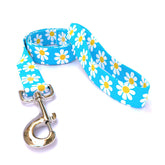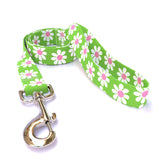Dog Walking Made Simple: Tips for Exercise, Training, and More
When it comes to walking your dog, humans tend to have their own agenda - exercise and potty. Get it done! But here are some tips for walking your dog to make sure you both get what you need!
Quick Tips for Better Walks:
- Allow time for sniffing and potty breaks.
- Bring water for longer walks.
- Use a well-fitted dog collar or harness like the Freedom No-Pull Harness.
- Watch for signs that your dog needs a break.
Potty Walks: Quick and Convenient
A Potty Walk is a short walk that can be used as a bathroom break or to help with housebreaking.

Depending on your schedule, you might need to just get outside for a quick break and save the longer walk for later. Or maybe it is bedtime, take care of business and get back inside!
Potty walks are essential for housebreaking and quick bathroom breaks. They're most effective first thing in the morning, after meals, or before bed. Pay attention to your dog’s body language to know when they’re ready to go. Use consistent commands like 'Go potty!' and then praise to reinforce behavior.
Quick tips for potty walks:
- Create a Routine: Dogs thrive on routine, so try to take potty walks at the same times each day to establish consistency. Use the same verbal cue like "go potty!" or "go peepee!"
- Use a Specific Spot: Designate a regular area for potty breaks to help your dog associate that spot with bathroom time. (this really helps if you are in a hurry in the morning!)
- Reward Success: Keep treats handy to reward your dog immediately after they go. This reinforces the behavior and makes housebreaking easier.
- Dress for Weather: If it is cold or rainy, consider a raincoat or fleece coat for warmth. Think about the ground they are walking on. If the pavement is hot, move to the grass, or if it is icy, consider boots.
Exercise Walks: For Physical Fitness
Exercise walks are great for keeping your dog fit and healthy. If you don’t have a fenced yard, dedicate specific walks to exercise. Use a sturdy leash or harness and maintain a brisk pace. Allow your dog to start with a quick sniff and potty break before focusing on movement.
Before you start an exercise walk, be sure and let your dog have a good sniff and a potty and then start with "come on" or "this way" to get the walk going.
If your dog starts lagging behind or wants to sniff everything, give them a chance to do that and then continue on with the faster walk.
Quick tips for your exercise walks:
- Vary the Terrain: Mix up your routes with hills, trails, or grassy fields to provide your dog with different types of exercise and stimulation.
- Add Challenges: For energetic dogs, incorporate challenges like jogging, running up stairs, or light agility exercises (like hopping over a branch)
- Watch for Overexertion: Especially in hot or cold weather, monitor your dog for signs of fatigue, such as excessive panting or slowing down, and take breaks and offer water as needed
- Choose the Right Gear: Use equipment like the Freedom No-Pull Harness to maintain control during brisk walks or runs without straining your dog.

Socialization Walks: Meet and Greet
A socialization walk is an excellent time for your dog to get some exercise, stretch its legs, and meet new friends. Socialization is essential for dogs because it helps them feel more confident in unfamiliar situations.
If your dog feels comfortable, you can approach other dogs and let them greet each other (there's nothing like a good booty sniff to get to know another dog!). Let people you meet approach and greet your dog - again, only if your dog feels comfortable.
Quick tips for Socialization walks:
- Practice Good Etiquette: Always ask for permission before approaching another dog or a person and teach your dog to approach calmly.
- Carry Treats for Positivity: Use treats to reward your dog for good behavior when meeting people or other dogs.
- Avoid Crowded Areas: Start with quiet parks or trails for dogs new to socialization and gradually work up to busier areas.
- Have a Backup Plan: If your dog gets overwhelmed, redirect their focus with commands like "watch me" or "heel," and calmly walk away.
Training Walks: Short and Focused
Keep it short: The best tip for dog training walks is they should only be 15-20 minutes at the most so your dog can stay focused.
Set some rules: Remember that your training walks will differ from regular ones. You may decide to stop in the middle of the walk to work on "outside training" ideas like sit, stay, or focus.
Quick tips for training walks:
- Set a Goal: Focus on one specific skill per walk, such as loose-leash walking or practicing "sit" in distracting environments.
- Use Clicker Training: Bring a clicker to mark desired behaviors, followed by a treat, for clearer communication.
- Change the Environment: Practice in different locations to help your dog generalize commands and respond in varied settings.
- End on a Positive Note: Always end the session with a success and reward to keep your dog motivated for future training walks.
Brain-Stimulation Walks: Let Them Lead
A Brain-Stimulation A dog walk is a walk that will engage the dog's brain. They get to sniff, explore, and wander around. Walks are a great way to help with behavior problems - remember, a tired dog is a good dog!
A great way to do this is to ask them which direction they would like to go and follow their lead. See where you end up! It can be fun to see what is interesting to you and your dog (but keep an eye out so you can get back home!)
Quick tips for brain stimulation walks:
- Incorporate Nose Work: Hide treats along your route or in your pockets to encourage sniffing and problem-solving.
- Ask Open Questions: Use commands like “find it” or let your dog choose paths at intersections to engage their curiosity.
- Bring Interactive Toys: Carry a toy or puzzle for added engagement during breaks.
- Mix in Training Elements: Let your dog explore freely, but occasionally ask for commands like "sit" or "wait" to blend stimulation with obedience.

Additional Tips for All Dog Walks
Here are some simple tips for making a walking your dog more enjoyable
- Carry Safety Essentials: Always bring poop bags, water, and a first-aid kit if you’re venturing far from home.
- Keep an Eye on the Weather: Adjust the duration and pace of walks based on temperature and weather conditions.
- Reflective Gear for Night Walks: Use reflective leashes, collars, or harnesses if walking in low-light conditions.
- Mind Their Paws: Check your dog’s paws after walks, especially on hot pavement or icy roads, to ensure they’re safe and injury-free.
Walking your dog is one of the best ways to bond and keep them happy and healthy. Whether it’s a quick potty break or a long brain-stimulation walk, each outing is an adventure. Grab your leash, explore together, and make every walk count!
If walks with your dog are a struggle, it may be time to find a good trainer to help. Search for a certified trainer near you on APDT's website.




